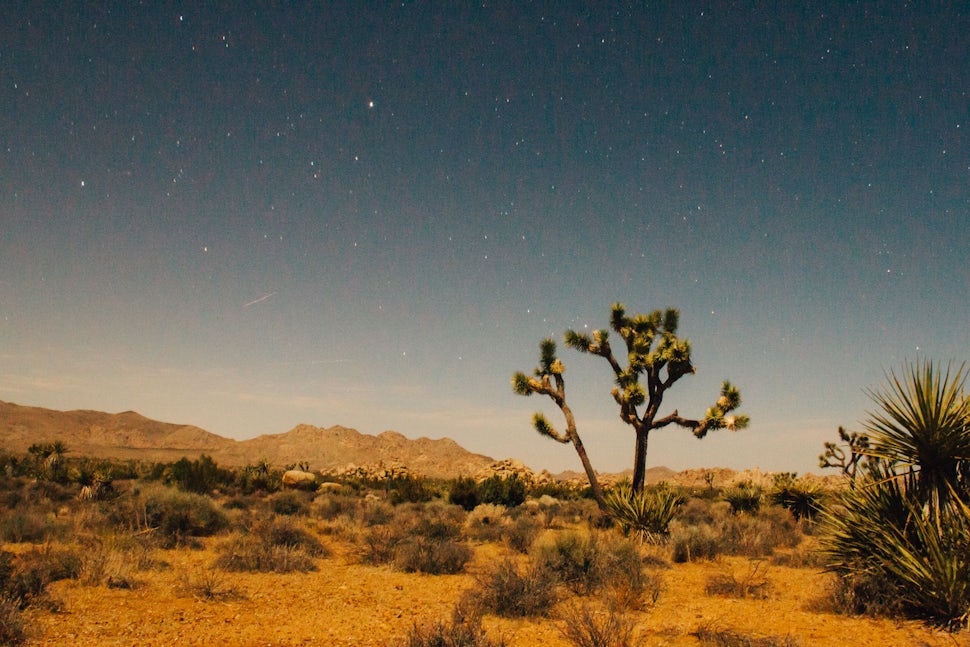24 Hours in Joshua Tree National Park
A guide for passing through one of the most unique national parks.

If you’re anything like me, when you venture out on a new road trip, you want to see everything there possibly is to see in the amount of time you have. This last spring we were on our drive back to Colorado from Mexico, and wanted to stop in Joshua Tree for a night to break up the drive. We came into the park late afternoon and left mid-day the next day, giving us about 24 hours to see everything we could. So if you’re passing through the park, might I suggest the following:
THE SALTEN SEA
Just south of Joshua Tree National Park is the Salton Sea, a strange place. You seemingly stumble upon a lake in the middle of the Mojave Desert. As you approach, you start to become excited thinking that it might be somewhere you can actually swim. With palm trees lining the shoreline and sand that is nearly white, what wouldn’t make this a swimming paradise? They say the sea is actually 25% saltier then the oceans, and is home to a numerous amount of different invasive species of fish. However what once used to be a paradise in the mid 20th century has sadly become a toxic waste land. The sea is drying up quickly and over the years has collected pesticides from farms in the area, killing off fish and contributing to a not so nice smell, and other undesirable attributes. Regardless of the sad state the Salton Sea is in, it won’t be there forever and is a very photogenic area to stop and see before entering the park, witnessing some history along the way.
COTTONWOOD SPRING
Our first stop in the park was at Cottonwood Spring just east of the Cottonwood Visitor Center. This stop provides access to the spring and the start of some trailheads. The spring is a short walk down from the parking lot and was formed from earthquakes! It was a popular spot for natives and settlers to gather water back in the day. This little stop in the park is known to be the best place to watch birds according to the parks website. As you approach the springs, you are among towering palms, bigger then any I’ve ever seen. It's definitely a worthwhile spot to stop and take in some very different views. This area is also visited less than the rest of the park, so there wont be as many crowds. If you have the time, hike the Lost Palm Oasis Trail. We didn’t get the chance, but heard it was superb.
CHOLLA CACTUS GRADEN AT SUNSET
After visiting the springs we hopped back on the highway in the park and headed north 21 miles to the Cholla Cactus Garden for sunset. The garden features a .25 mile neature* trail you can hop on to get a closer look at the “Teddybear Cholla” cacti. Make sure you don’t get too close, the cacti like to jump. On the park service site, you can learn about what different species are in bloom based on time of year in the garden. Most definitely a magical site to see at sunset.
*Yes, I meant to spell it "neature".
CAMP AT RYAN CAMPGROUND
The sun was setting quick, it was a Saturday night in the park, and we were on a mission to find the very last campsite, which I believe we did, no joke. We scoured about three campground before landing at Ryan, with one spot remaining. There were several hiking trails off of the campground. We took a little headlamp stroll to see the sights under the bright starry sky. The next morning we awoke refreshed, with just enough time for a small hike.
HIKE TO BARKER DAM
With time being of the essence, we set out to see one of the most favored and accessible hikes in the park, Baker Damn. The hike is a 1.1 mile loop, through lots of Joshua Trees. Along the path you’ll find critter life--we saw more then our fair share of hares (bunnies), squirrels and birds. Learn about all the variations of plants on the trail here. Near the far end of the loop you’ll find yourself at the dam, with standing water that attracts all sorts of birds - making it a peaceful place to sit and listen for just awhile.
After our visit at the dam, we set out for our next venture. We were able to get a taste of what Joshua Tree National Park had to offer in 24 hours (or maybe even less) and were able to make a “night on the road” much more worthwhile. I would highly suggest visiting the park in the spring or the fall, when it’s not quite as hot or as crowded. Happy trails and happy travels.
We want to acknowledge and thank the past, present, and future generations of all Native Nations and Indigenous Peoples whose ancestral lands we travel, explore, and play on. Always practice Leave No Trace ethics on your adventures and follow local regulations. Please explore responsibly!
Do you love the outdoors?
Yep, us too. That's why we send you the best local adventures, stories, and expert advice, right to your inbox.





















